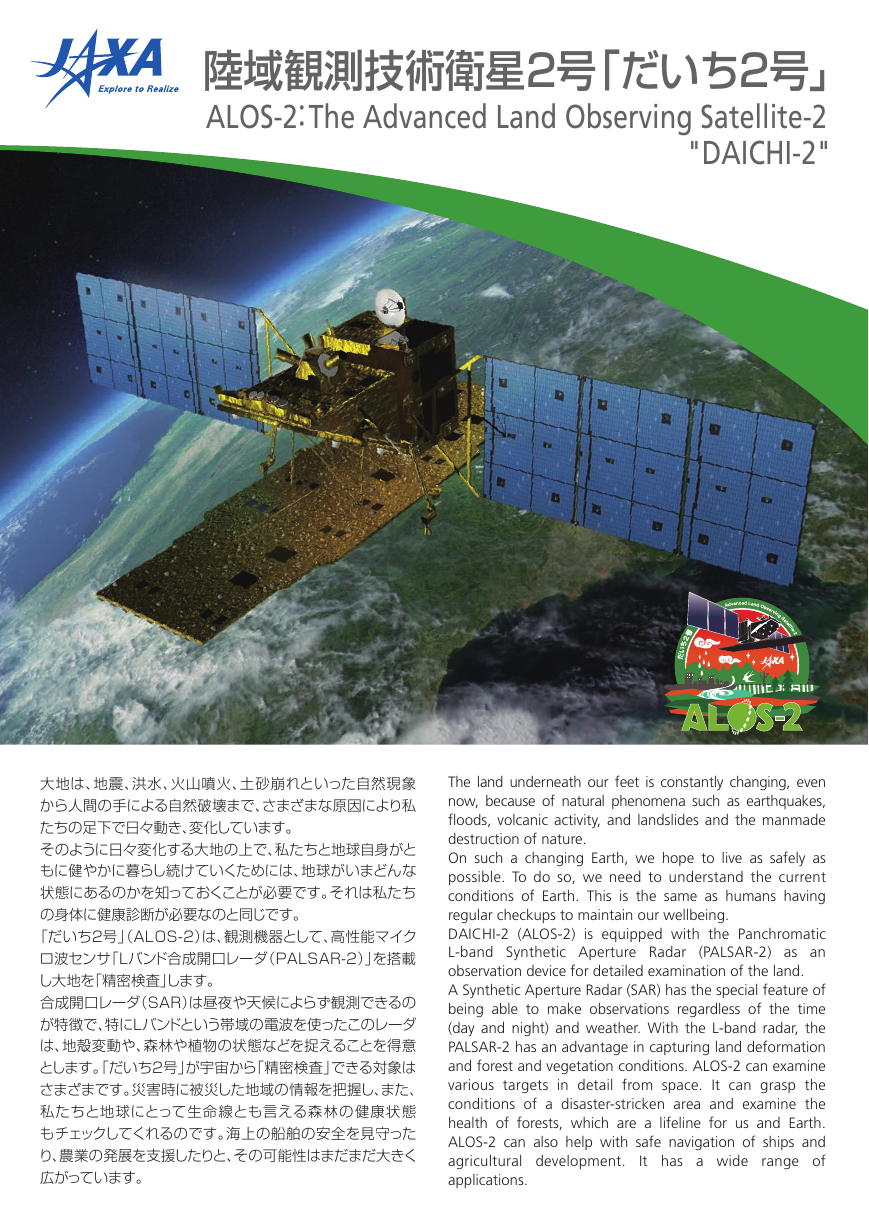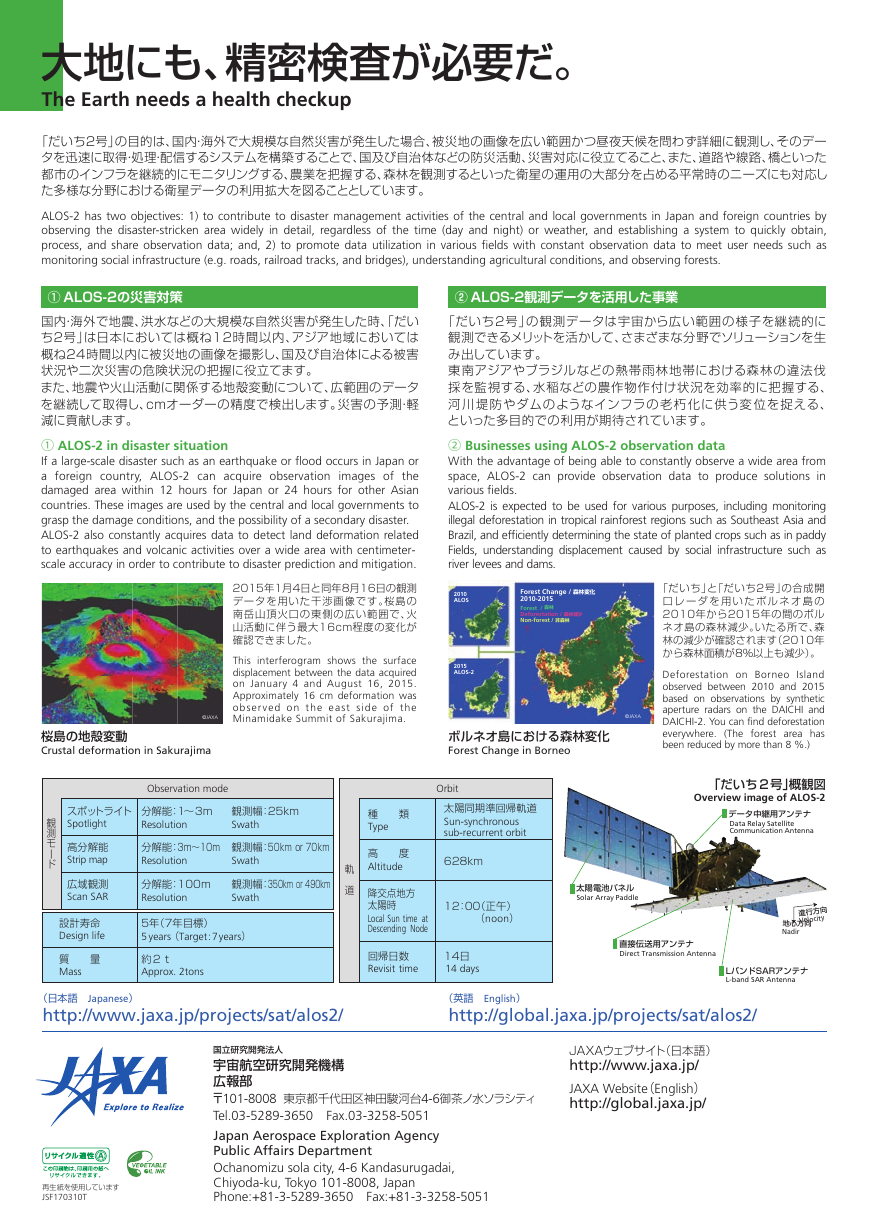陸域観測技術衛星2号「だいち2号」
ALOS-2:The Advanced Land Observing Satellite-2
"DAICHI-2"
大地は、地震、洪水、火山噴火、土砂崩れといった自然現象
から人間の手による自然破壊まで、さまざまな原因により私
たちの足下で日々動き、変化しています。
そのように日々変化する大地の上で、私たちと地球自身がと
もに健やかに暮らし続けていくためには、地球がいまどんな
状態にあるのかを知っておくことが必要です。それは私たち
の身体に健康診断が必要なのと同じです。
「だいち2号」(ALOS-2)は、観測機器として、高性能マイク
ロ波センサ「Lバンド合成開口レーダ(PALSAR-2)」を搭載
し大地を「精密検査」します。
合成開口レーダ(SAR)は昼夜や天候によらず観測できるの
が特徴で、特にLバンドという帯域の電波を使ったこのレーダ
は、地殻変動や、森林や植物の状態などを捉えることを得意
とします。「だいち2号」が宇宙から「精密検査」できる対象は
さまざまです。災害時に被災した地域の情報を把握し、また、
私たちと地球にとって生命線とも言える森林の健康状態
もチェックしてくれるのです。海上の船舶の安全を見守った
り、農業の発展を支援したりと、その可能性はまだまだ大きく
広がっています。
The land underneath our feet is constantly changing, even
now, because of natural phenomena such as earthquakes,
floods, volcanic activity, and landslides and the manmade
destruction of nature.
On such a changing Earth, we hope to live as safely as
possible. To do so, we need to understand the current
conditions of Earth. This is the same as humans having
regular checkups to maintain our wellbeing.
DAICHI-2 (ALOS-2) is equipped with the Panchromatic
L-band Synthetic Aperture Radar (PALSAR-2) as an
observation device for detailed examination of the land.
A Synthetic Aperture Radar (SAR) has the special feature of
being able to make observations regardless of the time
(day and night) and weather. With the L-band radar, the
PALSAR-2 has an advantage in capturing land deformation
and forest and vegetation conditions. ALOS-2 can examine
various targets in detail from space. It can grasp the
conditions of a disaster-stricken area and examine the
health of forests, which are a lifeline for us and Earth.
ALOS-2 can also help with safe navigation of ships and
agricultural development.
It has a wide range of
applications.
�
大地にも、精密検査が必要だ。
The Earth needs a health checkup
「だいち2号」の目的は、国内・海外で大規模な自然災害が発生した場合、被災地の画像を広い範囲かつ昼夜天候を問わず詳細に観測し、そのデー
タを迅速に取得・処理・配信するシステムを構築することで、国及び自治体などの防災活動、災害対応に役立てること、また、道路や線路、橋といった
都市のインフラを継続的にモニタリングする、農業を把握する、森林を観測するといった衛星の運用の大部分を占める平常時のニーズにも対応し
た多様な分野における衛星データの利用拡大を図ることとしています。
ALOS-2 has two objectives: 1) to contribute to disaster management activities of the central and local governments in Japan and foreign countries by
observing the disaster-stricken area widely in detail, regardless of the time (day and night) or weather, and establishing a system to quickly obtain,
process, and share observation data; and, 2) to promote data utilization in various fields with constant observation data to meet user needs such as
monitoring social infrastructure (e.g. roads, railroad tracks, and bridges), understanding agricultural conditions, and observing forests.
① ALOS-2の災害対策
国内・海外で地震、洪水などの大規模な自然災害が発生した時、「だい
ち2号」は日本においては概ね12時間以内、アジア地域においては
概ね24時間以内に被災地の画像を撮影し、国及び自治体による被害
状況や二次災害の危険状況の把握に役立てます。
また、地震や火山活動に関係する地殻変動について、広範囲のデータ
を継続して取得し、cmオーダーの精度で検出します。災害の予測・軽
減に貢献します。
② ALOS-2観測データを活用した事業
「だいち2号」の観測データは宇宙から広い範囲の様子を継続的に
観測できるメリットを活かして、さまざまな分野でソリューションを生
み出しています。
東南アジアやブラジルなどの熱帯雨林地帯における森林の違法伐
採を監視する、水稲などの農作物作付け状況を効率的に把握する、
河川堤防やダムのようなインフラの老朽化に供う変位を捉える、
といった多目的での利用が期待されています。
① ALOS-2 in disaster situation
If a large-scale disaster such as an earthquake or flood occurs in Japan or
a foreign country, ALOS-2 can acquire observation images of the
damaged area within 12 hours for Japan or 24 hours for other Asian
countries. These images are used by the central and local governments to
grasp the damage conditions, and the possibility of a secondary disaster.
ALOS-2 also constantly acquires data to detect land deformation related
to earthquakes and volcanic activities over a wide area with centimeter-
scale accuracy in order to contribute to disaster prediction and mitigation.
② Businesses using ALOS-2 observation data
With the advantage of being able to constantly observe a wide area from
space, ALOS-2 can provide observation data to produce solutions in
various fields.
ALOS-2 is expected to be used for various purposes, including monitoring
illegal deforestation in tropical rainforest regions such as Southeast Asia and
Brazil, and efficiently determining the state of planted crops such as in paddy
Fields, understanding displacement caused by social infrastructure such as
river levees and dams.
2015年1月4日と同年8月16日の観測
データを用いた干渉画像です。桜島の
南岳山頂火口の東側の広い範囲で、火
山活動に伴う最大16cm程度の変化が
確認できました。
This interferogram shows the surface
displacement between the data acquired
on January 4 and August 16, 2015.
Approximately 16 cm deformation was
observed on the east side of the
Minamidake Summit of Sakurajima.
Forest Change / 森林変化
2010-2015
Forest / 森林
Deforestation / 森林減少
Non-forest / 非森林
2010
ALOS
2015
ALOS-2
ボルネオ島における森林変化
Forest Change in Borneo
©JAXA
桜島の地殻変動
Crustal deformation in Sakurajima
©JAXA
観
測
モ
ー
ド
Observation mode
スポットライト
Spotlight
分解能:1〜3m 観測幅:25km
Resolution
Swath
高分解能
Strip map
広域観測
Scan SAR
設計寿命
Design life
質 量
Mass
分解能:3m〜10m 観測幅:50km or 70km
Resolution
Swath
分解能:100m 観測幅:350km or 490km
Resolution
Swath
軌
道
5年(7年目標)
5 years (Target: 7 years)
約2t
Approx. 2tons
Orbit
太陽同期準回帰軌道
Sun-synchronous
sub-recurrent orbit
628km
種 類
Type
高 度
Altitude
降交点地方
太陽時
Local Sun time at
Descending Node
12:00(正午)
(noon)
回帰日数
Revisit time
14日
14 days
「だいち」と「だいち2号」の合成開
口レーダを用いたボルネオ島の
2010年から2015年の間のボル
ネオ島の森林減少。いたる所で、森
林の減少が確認されます(2010年
から森林面積が8%以上も減少)。
Deforestation on Borneo Island
observed between 2010 and 2015
based on observations by synthetic
aperture radars on the DAICHI and
DAICHI-2. You can find deforestation
everywhere. (The forest area has
been reduced by more than 8 %.)
「だいち2号」概観図
Overview image of ALOS-2
データ中継用アンテナ
Data Relay Satellite
Communication Antenna
太陽電池パネル
Solar Array Paddle
直接伝送用アンテナ
Direct Transmission Antenna
進 行 方 向
V e l o c i t y
地心方向
Nadir
LバンドSARアンテナ
L-band SAR Antenna
(日本語 Japanese)
http://www.jaxa.jp/projects/sat/alos2/
(英語 English)
http://global.jaxa.jp/projects/sat/alos2/
国立研究開発法人
宇宙航空研究開発機構
広報部
〒101-8008 東京都千代田区神田駿河台4-6御茶ノ水ソラシティ
Tel.03-5289-3650 Fax.03-3258-5051
Japan Aerospace Exploration Agency
Public Affairs Department
Ochanomizu sola city, 4-6 Kandasurugadai,
Chiyoda-ku, Tokyo 101-8008, Japan
Phone:+81-3-5289-3650 Fax:+81-3-3258-5051
JAXAウェブサイト(日本語)
http://www.jaxa.jp/
JAXA Website(English)
http://global.jaxa.jp/
再生紙を使用しています
JSF170310T
�




 2023年江西萍乡中考道德与法治真题及答案.doc
2023年江西萍乡中考道德与法治真题及答案.doc 2012年重庆南川中考生物真题及答案.doc
2012年重庆南川中考生物真题及答案.doc 2013年江西师范大学地理学综合及文艺理论基础考研真题.doc
2013年江西师范大学地理学综合及文艺理论基础考研真题.doc 2020年四川甘孜小升初语文真题及答案I卷.doc
2020年四川甘孜小升初语文真题及答案I卷.doc 2020年注册岩土工程师专业基础考试真题及答案.doc
2020年注册岩土工程师专业基础考试真题及答案.doc 2023-2024学年福建省厦门市九年级上学期数学月考试题及答案.doc
2023-2024学年福建省厦门市九年级上学期数学月考试题及答案.doc 2021-2022学年辽宁省沈阳市大东区九年级上学期语文期末试题及答案.doc
2021-2022学年辽宁省沈阳市大东区九年级上学期语文期末试题及答案.doc 2022-2023学年北京东城区初三第一学期物理期末试卷及答案.doc
2022-2023学年北京东城区初三第一学期物理期末试卷及答案.doc 2018上半年江西教师资格初中地理学科知识与教学能力真题及答案.doc
2018上半年江西教师资格初中地理学科知识与教学能力真题及答案.doc 2012年河北国家公务员申论考试真题及答案-省级.doc
2012年河北国家公务员申论考试真题及答案-省级.doc 2020-2021学年江苏省扬州市江都区邵樊片九年级上学期数学第一次质量检测试题及答案.doc
2020-2021学年江苏省扬州市江都区邵樊片九年级上学期数学第一次质量检测试题及答案.doc 2022下半年黑龙江教师资格证中学综合素质真题及答案.doc
2022下半年黑龙江教师资格证中学综合素质真题及答案.doc